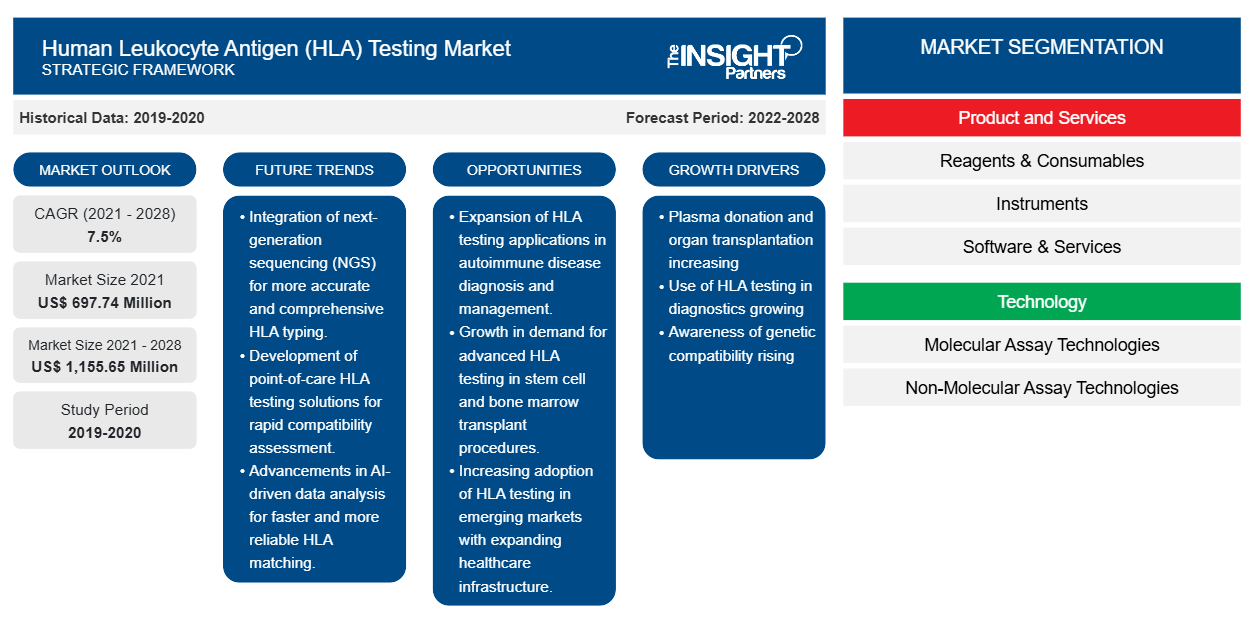من المتوقع أن يصل سوق اختبار مستضد الكريات البيضاء البشرية (HLA) إلى 1،155.65 مليون دولار أمريكي بحلول عام 2028 من 697.74 مليون دولار أمريكي في عام 2021؛ ومن المتوقع أن يسجل معدل نمو سنوي مركب بنسبة 7.5٪ من عام 2022 إلى عام 2028.
تلعب مستضدات الكريات البيضاء البشرية دورًا أساسيًا في الاستجابة المناعية للجسم للمواد الخارجية. الاستخدام الرئيسي لاختبار مستضدات الكريات البيضاء البشرية هو مطابقة متلقي زراعة الأعضاء والأنسجة مع المتبرعين المتوافقين. يتضمن اختبار مستضدات الكريات البيضاء البشرية أيضًا فحص متلقي زراعة الأعضاء بحثًا عن وجود أجسام مضادة قد تستهدف الأنسجة أو العضو المتبرع به كجزء من الاستجابة المناعية.
يقدم التقرير رؤى وتحليلات متعمقة لسوق اختبار مستضد الكريات البيضاء البشرية (HLA) مع التركيز على اتجاهات السوق والتقدم التكنولوجي وديناميكيات السوق، من بين أمور أخرى. كما يوفر تحليلًا للمنافسة بين اللاعبين الرائدين في السوق على مستوى العالم. علاوة على ذلك، يتضمن تأثير جائحة COVID-19 على السوق في جميع المناطق الرئيسية. خلقت جائحة COVID-19 أزمة صحية عامة وأزمة اقتصادية في جميع أنحاء العالم. قبل الوباء، كان سوق اختبار مستضد الكريات البيضاء البشرية (HLA) ينمو باستمرار بسبب الانتظام في تقييم المتبرعين بالأعضاء والتعزية والعلاجات. أدت الموجة الأولى من COVID-19 إلى تعطيل الاستشارات والمتابعات والفحوصات المتعلقة بأمراض أخرى غير COVID-19. تكبدت العديد من الشركات خسائر فادحة في الربع الأخير من عام 2019؛ كان للوباء بشكل خاص آثار سلبية على السوق العالمية في الربعين الأول والثاني من عام 2020. تعطلت الشركات في جميع أنحاء العالم بسبب تعطل سلاسل التوريد وزيادة الطلب على منتجات وخدمات الرعاية الصحية. لتقليل الإصابة بفيروس كورونا المستجد في المستشفيات والعيادات، تبنى ممارسو الرعاية الصحية والمرضى علاج مرضاهم عن بُعد وفضلوا ذلك. كما أعاقت هذه الظروف غير المتوقعة إجراءات زراعة الأعضاء. تم إلغاء أو تأجيل العديد من العلاجات الجراحية والاستشارات غير العاجلة، وتم تعليق العمليات الجراحية الاختيارية في العديد من المؤسسات للحد من انتشار فيروس كورونا المستجد وكذلك لحجز وإعادة تخصيص الموارد، بما في ذلك أفراد الرعاية الصحية (الممرضات وأطباء التخدير)، والمعدات الطبية (معدات الحماية الشخصية وأجهزة التنفس الصناعي)، والأسرة. أدت توصية "البقاء في المنزل" إلى انخفاض كبير في جراحات التبرع بالأعضاء وزرع الأعضاء. قيدت هذه الظروف نمو سوق اختبار مستضد الكريات البيضاء البشرية (HLA) في جميع أنحاء العالم في عام 2020.
قم بتخصيص هذا التقرير ليناسب متطلباتك
ستحصل على تخصيص لأي تقرير - مجانًا - بما في ذلك أجزاء من هذا التقرير، أو تحليل على مستوى الدولة، وحزمة بيانات Excel، بالإضافة إلى الاستفادة من العروض والخصومات الرائعة للشركات الناشئة والجامعات
- احصل على أهم اتجاهات السوق الرئيسية لهذا التقرير.ستتضمن هذه العينة المجانية تحليلاً للبيانات، بدءًا من اتجاهات السوق وحتى التقديرات والتوقعات.
رؤى السوق:
زيادة عدد عمليات التبرع بالبلازما وزراعة الأعضاء تدفع نمو السوق
مستضدات الكريات البيضاء البشرية (HLA) هي البروتينات المتخصصة الموجودة على جميع أسطح خلايا جسم الإنسان، باستثناء خلايا الدم الحمراء. اختبار HLA له تطبيق كبير في زراعة الأعضاء ، والذي يمكن التوصية به كجزء من علاج الفشل الكلوي وتليف الكبد المزمن وأمراض القلب المزمنة، من بين القضايا الطبية الأخرى. يؤدي الانتشار المتزايد للأمراض المزمنة وفشل الأعضاء إلى ارتفاع الطلب على إجراءات زراعة الأعضاء، بالإضافة إلى اختبار HLA. قبل الزرع، يتم إجراء اختبار HLA للتحقق من توافق الأنسجة بين المرضى والمتبرعين لتجنب رفض الطعم. في السنوات الأخيرة، أصبحت زراعة الأعضاء ممارسة ناجحة في جميع أنحاء العالم. وفقًا للبيانات المنشورة في المرصد العالمي للتبرع والزراعة (GODT)، في عام 2020، تم تسجيل 129681 عملية زرع أعضاء في المجموع. ومن بين هؤلاء، كانت 31.7٪ عمليات زرع كلى حية و20.40٪ عمليات زرع كبد حية.
تتخذ حكومات بلدان مختلفة مبادرات لنشر الوعي حول الحاجة إلى التبرع بالأعضاء وفوائد زراعة الأعضاء في إجراءات علاجية معينة. على سبيل المثال، نفذت شبكة الحصول على الأعضاء وزراعتها (OPTN) بعض الاستراتيجيات لتحسين عدد إجراءات زراعة الأعضاء في الولايات المتحدة. تركز هذه الاستراتيجيات على زيادة عدد عمليات زرع الأعضاء والأنسجة بين المرضى المصابين بأمراض الأعضاء في المرحلة النهائية، وتغيير توزيع الأعضاء الحالي، وتعديل قائمة انتظار زراعة الأعضاء من خلال إعادة توزيع الأعضاء المتحللة الموجودة. علاوة على ذلك، استخدمت شبكة الحصول على الأعضاء وزراعتها استراتيجيات خارج الصندوق لتحسين زراعة الأعضاء. تتضمن هذه الاستراتيجيات المبتكرة الاستخدام الأمثل للأعضاء التي تم الحصول عليها من المرضى المتوفين [على سبيل المثال، التبرع بعد الموت القلبي (DCD) أو المتبرعين الذين ماتوا دماغيًا]، والحد من التخلص من الأعضاء، وتشجيع التبرع بالأعضاء من الأحياء، وتحسين معدل ترخيص التبرع بالأعضاء المحتمل.
وبالتالي، فإن الطلب المتزايد على زراعة الأعضاء يؤدي إلى الحاجة إلى عدد أكبر من أدوات اختبار HLA والمواد الاستهلاكية، مما يدفع نمو سوق اختبار HLA.
رؤى قائمة على المنتجات والخدمات
بناءً على المنتج والخدمات، يتم تقسيم سوق اختبار مستضد الكريات البيضاء البشرية (HLA) إلى الكواشف والمواد الاستهلاكية والأجهزة والبرامج والخدمات. في عام 2021، احتل قطاع الكواشف والمواد الاستهلاكية الحصة الأكبر من السوق، ومن المتوقع أن يسجل أسرع معدل نمو سنوي مركب بنسبة 7.5٪ خلال الفترة المتوقعة.
رؤى مبنية على التكنولوجيا
بناءً على التكنولوجيا، يتم تقسيم سوق اختبار مستضد الكريات البيضاء البشرية (HLA) إلى تقنيات التحليل الجزيئي وتقنيات التحليل غير الجزيئي. في عام 2021، استحوذ قطاع تقنيات التحليل الجزيئي على أكبر حصة من السوق، ومن المتوقع أن يسجل معدل نمو سنوي مركب أعلى بنسبة 7.7% خلال الفترة 2022-2028.
رؤى تعتمد على المستخدم النهائي
بناءً على المستخدم النهائي، يتم تقسيم سوق اختبار مستضد الكريات البيضاء البشرية (HLA) إلى مختبرات مرجعية مستقلة ومستشفيات ومراكز زراعة الأعضاء وغيرها. في عام 2021، احتل قطاع المختبرات المرجعية المستقلة الحصة الأكبر من السوق. ومع ذلك، من المتوقع أن يسجل قطاع المستشفيات ومراكز زراعة الأعضاء أعلى معدل نمو سنوي مركب بنسبة 7.9٪ خلال الفترة 2022-2028
يتبنى اللاعبون في سوق اختبار مستضد الكريات البيضاء البشرية (HLA) استراتيجيات عضوية مثل إطلاق المنتج وتوسيعه لتوسيع بصمتهم ومحفظة منتجاتهم في جميع أنحاء العالم، إلى جانب تلبية الطلبات المتزايدة على المنتجات.
حسب الجغرافيا
على أساس الجغرافيا، يتم تقسيم سوق اختبار مستضد الكريات البيضاء البشرية (HLA) إلى أمريكا الشمالية (الولايات المتحدة وكندا والمكسيك)، وأوروبا (المملكة المتحدة وألمانيا وفرنسا وإيطاليا وإسبانيا وبقية أوروبا)، وآسيا والمحيط الهادئ (الصين واليابان والهند وأستراليا وكوريا الجنوبية وبقية آسيا والمحيط الهادئ)، والشرق الأوسط وأفريقيا (الإمارات العربية المتحدة والمملكة العربية السعودية وجنوب أفريقيا وبقية الشرق الأوسط وأفريقيا)، وأمريكا الجنوبية والوسطى (البرازيل والأرجنتين وبقية أمريكا الجنوبية والوسطى).
اختبار مستضد الكريات البيضاء البشرية
رؤى إقليمية حول سوق اختبار مستضد الكريات البيضاء البشرية (HLA)
لقد قام المحللون في Insight Partners بشرح الاتجاهات والعوامل الإقليمية المؤثرة على سوق اختبار مستضد الكريات البيضاء البشرية (HLA) طوال فترة التنبؤ بشكل شامل. يناقش هذا القسم أيضًا قطاعات سوق اختبار مستضد الكريات البيضاء البشرية (HLA) والجغرافيا في جميع أنحاء أمريكا الشمالية وأوروبا ومنطقة آسيا والمحيط الهادئ والشرق الأوسط وأفريقيا وأمريكا الجنوبية والوسطى.

- احصل على البيانات الإقليمية المحددة لسوق اختبار مستضد الكريات البيضاء البشرية (HLA)
نطاق تقرير سوق اختبار مستضد الكريات البيضاء البشرية (HLA)
| سمة التقرير | تفاصيل |
|---|---|
| حجم السوق في عام 2021 | 697.74 مليون دولار أمريكي |
| حجم السوق بحلول عام 2028 | 1,155.65 مليون دولار أمريكي |
| معدل النمو السنوي المركب العالمي (2021 - 2028) | 7.5% |
| البيانات التاريخية | 2019-2020 |
| فترة التنبؤ | 2022-2028 |
| القطاعات المغطاة | حسب المنتج والخدمات
|
| المناطق والدول المغطاة | أمريكا الشمالية
|
| قادة السوق وملفات تعريف الشركات الرئيسية |
|
كثافة اللاعبين في سوق اختبار مستضد الكريات البيضاء البشرية (HLA): فهم تأثيرها على ديناميكيات الأعمال
يشهد سوق اختبار مستضد الكريات البيضاء البشرية (HLA) نموًا سريعًا، مدفوعًا بالطلب المتزايد من المستخدم النهائي بسبب عوامل مثل تفضيلات المستهلك المتطورة والتقدم التكنولوجي والوعي الأكبر بفوائد المنتج. ومع ارتفاع الطلب، تعمل الشركات على توسيع عروضها والابتكار لتلبية احتياجات المستهلكين والاستفادة من الاتجاهات الناشئة، مما يؤدي إلى زيادة نمو السوق.
تشير كثافة اللاعبين في السوق إلى توزيع الشركات أو المؤسسات العاملة في سوق أو صناعة معينة. وهي تشير إلى عدد المنافسين (اللاعبين في السوق) الموجودين في مساحة سوق معينة نسبة إلى حجمها أو قيمتها السوقية الإجمالية.
الشركات الرئيسية العاملة في سوق اختبار مستضد الكريات البيضاء البشرية (HLA) هي:
- شركة ثيرمو فيشر العلمية
- كيردكس
- كياجن
- شركة إيلومينا
- مختبرات بيو راد، المحدودة
إخلاء المسؤولية : الشركات المذكورة أعلاه ليست مرتبة بأي ترتيب معين.

- احصل على نظرة عامة على أهم اللاعبين الرئيسيين في سوق اختبار مستضد الكريات البيضاء البشرية (HLA)
نبذة عن الشركة
- شركة ثيرمو فيشر العلمية
- كيردكس
- كياجن
- شركة إيلومينا
- مختبرات بيو راد، المحدودة
- شركة تي بي جي للتشخيصات المحدودة
- شركة ف. هوفمان-لا روش المحدودة
- شركة تاكارا بيو
- شركة لومينكس
- شركة أوميكسون
- مركز التسلسل
- بروترانس
- هيستوجينيتكس ذ.م.م.
- سي دي جينوميكس
- قنيطرة للعلوم البيولوجية
- شركة سيجات المحدودة
- شركة كرييتيف بيولابس المحدودة
- التحليل التاريخي (سنتان)، السنة الأساسية، التوقعات (7 سنوات) مع معدل النمو السنوي المركب
- تحليل PEST و SWOT
- حجم السوق والقيمة / الحجم - عالميًا وإقليميًا وقطريًا
- الصناعة والمنافسة
- مجموعة بيانات Excel



Report Coverage
Revenue forecast, Company Analysis, Industry landscape, Growth factors, and Trends

Segment Covered
This text is related
to segments covered.

Regional Scope
North America, Europe, Asia Pacific, Middle East & Africa, South & Central America

Country Scope
This text is related
to country scope.
الأسئلة الشائعة
Global human leukocyte antigen (HLA) testing market is segmented by region into North America, Europe, Asia Pacific, Middle East & Africa, and South & Central America. In North America, the U.S. is the largest market for human leukocyte antigen (HLA) testing market. The US is estimated to hold the largest share in the human leukocyte antigen (HLA) testing market during the forecast period. The presence of top players and favorable regulations related to product approvals coupled with commercializing new products are the contributing factors for the regional growth. Additionally, the increasing number of technological advancements is the key factor responsible for the Asia-Pacific regional growth for human leukocyte antigen (HLA) testing accounting fastest growth of the region during the coming years.
Thermo Fisher Scientific, Inc., CareDx, Inc., Qiagen N.V., Illumina, Bio-Rad Laboratories, Inc., TGB Diagnostics Ltd., F. Hoffman La-Roche Ltd., Takara Bio, Luminex Corporation, Oximon, The Sequencing Center, Protrans, HistoGenetics LLC, CD Genomics, Quintara Biosciences, CeGaT GmbH, Creative Biolabs, Inc., are among the leading companies operating in the global human leukocyte antigen (HLA) testing market
The molecular assay technologies segment dominated the global human leukocyte antigen (HLA) testing market and is likely to account for the revenue of US$ 626.86 million in 2022.
Human leukocyte antigens play an essential part in the body's immune response to external substances. The principal use for human leukocyte antigen (HLA) testing is to match organ and tissue transplant recipients with compatible donors. HLA testing also involves screening transplant recipients for the presence of antibodies that might target the donated tissue or organ as part of an immune response.
Increasing plasma donation and organ transplants procedures is one of the most significant factors responsible for the overall market growth.
Based on product and service type, reagent and consumables took the forefront leaders in the worldwide market by accounting largest share in 2021 and is expected to continue to do so till the forecast period.
Trends and growth analysis reports related to Life Sciences : READ MORE..
The List of Companies - Human Leukocyte Antigen (HLA) Market
- Thermo Fisher Scientific Inc.
- CareDx
- Qiagen
- Illumina Inc.
- Bio-Rad Laboratories, Inc.
- TBG Diagnostics Limited
- F.Hoffmann-La Roche Ltd.
- Takara Bio Inc.
- Luminex Corporation
- Omixon Inc.
- The Sequencing Center
- Protrans
- HistoGenetics LLC.
- CD Genomics
- Qunitara Biosciences
- CeGat GmbH
- Creative Biolabs Inc.
The Insight Partners performs research in 4 major stages: Data Collection & Secondary Research, Primary Research, Data Analysis and Data Triangulation & Final Review.
- Data Collection and Secondary Research:
As a market research and consulting firm operating from a decade, we have published and advised several client across the globe. First step for any study will start with an assessment of currently available data and insights from existing reports. Further, historical and current market information is collected from Investor Presentations, Annual Reports, SEC Filings, etc., and other information related to company’s performance and market positioning are gathered from Paid Databases (Factiva, Hoovers, and Reuters) and various other publications available in public domain.
Several associations trade associates, technical forums, institutes, societies and organization are accessed to gain technical as well as market related insights through their publications such as research papers, blogs and press releases related to the studies are referred to get cues about the market. Further, white papers, journals, magazines, and other news articles published in last 3 years are scrutinized and analyzed to understand the current market trends.
- Primary Research:
The primarily interview analysis comprise of data obtained from industry participants interview and answers to survey questions gathered by in-house primary team.
For primary research, interviews are conducted with industry experts/CEOs/Marketing Managers/VPs/Subject Matter Experts from both demand and supply side to get a 360-degree view of the market. The primary team conducts several interviews based on the complexity of the markets to understand the various market trends and dynamics which makes research more credible and precise.
A typical research interview fulfils the following functions:
- Provides first-hand information on the market size, market trends, growth trends, competitive landscape, and outlook
- Validates and strengthens in-house secondary research findings
- Develops the analysis team’s expertise and market understanding
Primary research involves email interactions and telephone interviews for each market, category, segment, and sub-segment across geographies. The participants who typically take part in such a process include, but are not limited to:
- Industry participants: VPs, business development managers, market intelligence managers and national sales managers
- Outside experts: Valuation experts, research analysts and key opinion leaders specializing in the electronics and semiconductor industry.
Below is the breakup of our primary respondents by company, designation, and region:

Once we receive the confirmation from primary research sources or primary respondents, we finalize the base year market estimation and forecast the data as per the macroeconomic and microeconomic factors assessed during data collection.
- Data Analysis:
Once data is validated through both secondary as well as primary respondents, we finalize the market estimations by hypothesis formulation and factor analysis at regional and country level.
- Macro-Economic Factor Analysis:
We analyse macroeconomic indicators such the gross domestic product (GDP), increase in the demand for goods and services across industries, technological advancement, regional economic growth, governmental policies, the influence of COVID-19, PEST analysis, and other aspects. This analysis aids in setting benchmarks for various nations/regions and approximating market splits. Additionally, the general trend of the aforementioned components aid in determining the market's development possibilities.
- Country Level Data:
Various factors that are especially aligned to the country are taken into account to determine the market size for a certain area and country, including the presence of vendors, such as headquarters and offices, the country's GDP, demand patterns, and industry growth. To comprehend the market dynamics for the nation, a number of growth variables, inhibitors, application areas, and current market trends are researched. The aforementioned elements aid in determining the country's overall market's growth potential.
- Company Profile:
The “Table of Contents” is formulated by listing and analyzing more than 25 - 30 companies operating in the market ecosystem across geographies. However, we profile only 10 companies as a standard practice in our syndicate reports. These 10 companies comprise leading, emerging, and regional players. Nonetheless, our analysis is not restricted to the 10 listed companies, we also analyze other companies present in the market to develop a holistic view and understand the prevailing trends. The “Company Profiles” section in the report covers key facts, business description, products & services, financial information, SWOT analysis, and key developments. The financial information presented is extracted from the annual reports and official documents of the publicly listed companies. Upon collecting the information for the sections of respective companies, we verify them via various primary sources and then compile the data in respective company profiles. The company level information helps us in deriving the base number as well as in forecasting the market size.
- Developing Base Number:
Aggregation of sales statistics (2020-2022) and macro-economic factor, and other secondary and primary research insights are utilized to arrive at base number and related market shares for 2022. The data gaps are identified in this step and relevant market data is analyzed, collected from paid primary interviews or databases. On finalizing the base year market size, forecasts are developed on the basis of macro-economic, industry and market growth factors and company level analysis.
- Data Triangulation and Final Review:
The market findings and base year market size calculations are validated from supply as well as demand side. Demand side validations are based on macro-economic factor analysis and benchmarks for respective regions and countries. In case of supply side validations, revenues of major companies are estimated (in case not available) based on industry benchmark, approximate number of employees, product portfolio, and primary interviews revenues are gathered. Further revenue from target product/service segment is assessed to avoid overshooting of market statistics. In case of heavy deviations between supply and demand side values, all thes steps are repeated to achieve synchronization.
We follow an iterative model, wherein we share our research findings with Subject Matter Experts (SME’s) and Key Opinion Leaders (KOLs) until consensus view of the market is not formulated – this model negates any drastic deviation in the opinions of experts. Only validated and universally acceptable research findings are quoted in our reports.
We have important check points that we use to validate our research findings – which we call – data triangulation, where we validate the information, we generate from secondary sources with primary interviews and then we re-validate with our internal data bases and Subject matter experts. This comprehensive model enables us to deliver high quality, reliable data in shortest possible time.


 احصل على عينة مجانية لهذا التقرير
احصل على عينة مجانية لهذا التقرير